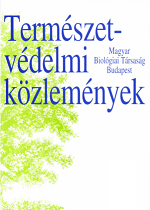Methodological questions of organic matter decomposition in the soil of a protected sand grassland
Abstract
Organic matter decomposition was studied in a climate change field experiment. The decomposition of the two dominant grass species of open sand grasslands were measured with the minicontainer method, and the decomposition of a standard organic matter was measured using tea bag method. We aimed to answer the following questions: Do the two methods lead to similar results in estimating decomposition dynamics? Does the one month extreme drought affect decomposition rates? Do the decomposition rates differ between plant species (Festuca vaginata vs. Stipa borysthenica), plant
parts (shoot vs. root) and the soil depths (0-5 cm vs. 10-15 cm)? Based on the results of the first period of the experiment, 15.45% of the total organic matter was decomposed with the minicontainer method and 15.8% with the tea bag method. The drought treatment did not significantly affect decomposition rate, but plant species, plant part and soil depth had strong significant effects on the decomposition rate. The losses were greater for Festuca vaginata, for plant shoot and in deeper soil layer. Based on these results, both methods are sensitive enough to assess the decomposition dynamics in open sand grassland.
References
Eilers, K. G., Debenport, S., Anderson, S. & Fierer, N. (2012): Digging deeper to find unique microbial communities: The strong effect of depth on the structure of bacterial and archaeal communities in soil. – Soil Biol. Biochem. 50: 58–65.
Eisenbeis, G., Lenz, R. & Heiber, T. (1999): Organic Residue Decomposition: The Minicontainer-System A Multifunctional Tool in Decompositiion Studies. – Environ. Sci. Pollut. Res. 6 (4): 220–224.
Ekelund, F., Rùnn, R. & Christensen, S. (2001): Distribution with depth of protozoa, bacteria and fungi in soil profiles from three Danish forest sites. – Soil Biol. Biochem. 33: 475–481.
Galletti, G. C., Reeves, J. B., Bloomfield, J., Vogt, K. A. & Vogt, D. J. (1993): Analysis of leaf and fine-root litter from a subtropical montane rain forest by pyrolysis-gas chromatography mass spectrometry. – J. Anal. Appl. Pyrolysis. 27: 1–14.
Kemp, P. R., Reynolds, J. F., Virginiaz, R. A. & Whitford, W. G. (2003): Decomposition of leaf and root litter of Chihuahuan desert shrubs: effects of three years of summer drought. – J. Arid Environ. 53: 21–39.
Keplin, B. & Hüttl, R. F. (2001): Decomposition of root litter in Pinus sylvestris L. and Pinus nigra stands on carboniferous substrates in the Lusatian lignite mining district. – Ecol. Eng. 17(2-3): 285–296.
Keuskamp J. A, Dingemans B. J. J., Lehtinen T., Sarneel J. M. & Hefting M. M. (2013): Tea Bag Index: a novel approach to collect uniform decomposition data accross ecosystems. – Methods Ecol. Evol. 4 (11): 1070–1075.
Kirschbaum, M. U. F. (1995) The temperature dependence of soil organic matter decomposition, and the effect of global warming on soil organic C storage. – Soil. Biol. Biochem. 27 (6): 753–760.
Kovács-Láng E, Kröel-Dulay G, Kertész M, Fekete G, Bartha S, Mika J, Dobi-Wantuch I, Rédei T, Rajkai K, Hahn I. (2000) Changes in the composition of sand grasslands along a climatic gradient in Hungary and implications for climate change. – Phytocoenologia 30: 385–407.
Lenz R. & Eisenbeis G. (1998): An extraction method for nematodes in decomposition studies using the minicontainer-method. – Plant Soil 198: 109–116.
R core team (2013): R STATISZTIKAI PROGRAM: http://www.r-project.org/
Smith, P. (2012): Soils and climate change. – Curr. Opin. Environ. Sustainability 4: 539–544.
van Meeteren, M. J. M., Tietema, A., van Loon, E. E. & Verstraten, J. M. (2008): Microbial dynamics and litter decomposition under a changed climate in a Dutch heathland. – Appl. Soil Ecol. 38: 119–127.
Zhang, L. H., Tong, C., Marrs, R., Wang, T. E., Zhang, W. J. & Zeng, C. S. (2014): Comparing litter dynamics of Phragmites australis and Spartina alterniflora in a sub-tropical Chinese estuary: Contrasts in early and late decomposition. – Aquat. Bot. 117: 1–11.






